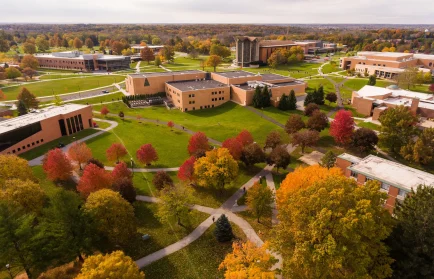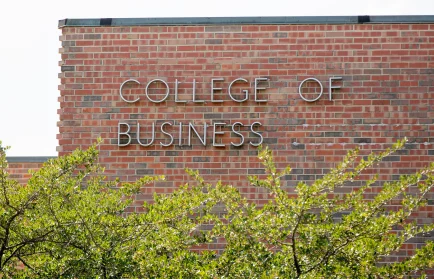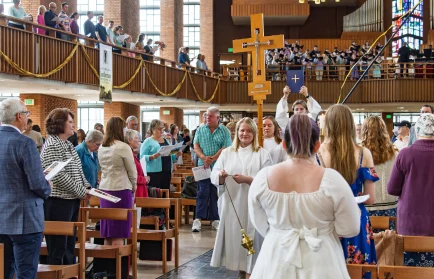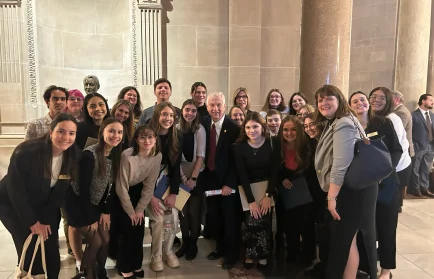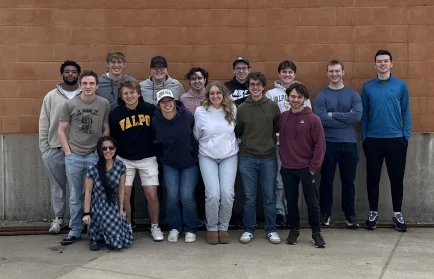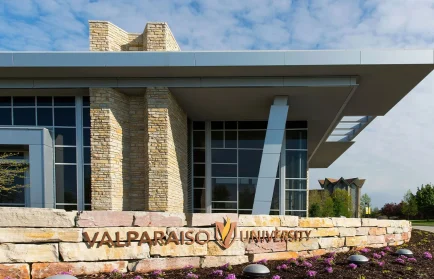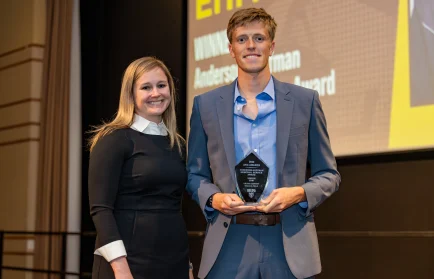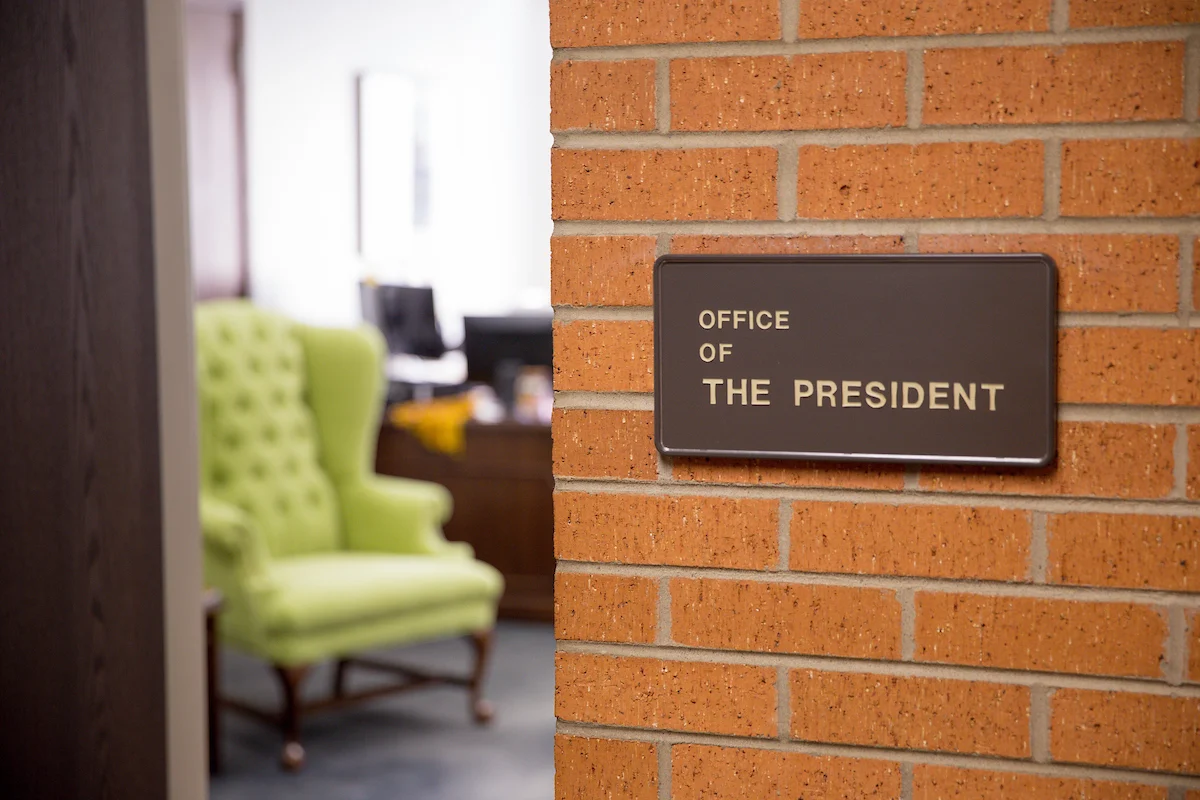Past Presidents
Since Valparaiso University was established in 1859 as a pioneer of coeducation, its presidents have led it through rapidly, sometimes dramatically changing times.
Leadership & governance
Explore Past Presidents
From Sept. 1, 2020 to Feb. 28, 2021, Colette Irwin-Knott ’81 B.S. assumed the role of Interim President of Valparaiso University, founded in 1859. Interim President Irwin-Knott is a dedicated servant leader with more than 30 years of experience in public finance.
Since 2009, Interim President Irwin-Knott has served as a member of the Valparaiso University Board of Directors. She sat on the Executive Committee of the Board, chaired its Finance and Administration Committee, participated in the Campus Life and Presidential Search Committees, and served on several AdHoc committees. She is also a member of the University Guild.
Previously, Interim President Irwin-Knott spent her career in the field of public finance with HJ Umbaugh & Associates in Indianapolis, retiring as a partner of the firm in 2014. She worked closely with educators throughout Indiana on hundreds of school and library projects involving the issuance of municipal bonds.
She has been an instrumental leader at local, state, and national levels of public finance and has represented independent financial advisors at the federal level as regulations were developed for this industry. While at Umbaugh, she began a women’s initiative for career development, and she has mentored numerous young women and men in their respective professions. Interim President Irwin-Knott has also been involved with Women in Public Finance in Indiana and served as president of the National Association of Independent Public Finance Advisors.
Guided by her faith, Interim President Irwin-Knott has a heart for service and has been active in ministries assisting inner-city teenage youth in Indianapolis. Her interests have also included the arts and serving on the Boards of the Indianapolis Public Library Foundation and The New Harmony Project. Among her many professional and charitable activities, the Indianapolis Business Journal recognized her as a “Woman in the Lead for Financial Services.”
Interim President Irwin-Knott earned her bachelor’s in business administration from Valparaiso University. During her time as a student, she was a member and president of Phi Beta Chi. She studied abroad in Cambridge, England, for a semester and was part of C-26.
Interim President Irwin-Knott grew up in Argos, Indiana, less than an hour from the University. Although she was a first-generation student, she had a pair of familial connections to Valpo that first led to her strong affinity for the University. Her uncle, Donald V. Fites, graduated in 1956 and is the namesake for the University’s Engineering Innovation Center, dedicated in 2011. Her aunt, Margaretta Tangerman served as the dean of women and retired as a professor emerita of social work in 1972.
While Interim President Irwin-Knott and her husband, Gary Knott, are joining the Valpo community, they have lived in Zionsville, Indiana. They are the parents of two adult sons, Aaron and Stefan, and attend Zionsville Presbyterian Church.
Under his leadership, the University diversified and expanded, launching numerous new undergraduate and graduate degree programs. He has also overseen the groundbreaking and dedications of more than seven new campus facilities and has established the Institute for Leadership and Service at Valparaiso University. President Heckler currently leads the $250 million Forever Valpo endowment-focused campaign, the largest fundraising effort in the University’s history.
President Heckler participates actively on numerous national and regional higher education boards and commissions, including previously serving as the chair of the Leadership Commission of the American Council on Education, and board chair of the New American Colleges and Universities, the Independent Colleges of Indiana, Indiana Campus Compact, and the One Region initiative for Northwest Indiana. He is currently a board member for the Council of Independent Colleges and the national Private College 529 Plan.
Previously, President Heckler served the University of Colorado Denver for more than a decade, including five years as provost and vice chancellor for academic and student affairs for the three-campus university, including its health sciences center. Prior to moving to Denver, he was professor of fine arts and director of theatre at Siena (New York) College, where he directed, acted in, designed, and/or produced more than 100 academic and professional productions in the United States, Europe, and the Middle East. He is also a past president of the Association for Theatre in Higher Education and founded and co-directed its Leadership Institute.
President Heckler earned his Ph.D. in educational leadership and innovation from the School of Education and Human Development at the University of Colorado. He completed his MFA in drama with an emphasis in directing at Catholic University in Washington, D.C., and earned his B.A. in communications summa cum laude at Elizabethtown (Pennsylvania) College.
President Heckler and his wife, Veronica, grew up together in Windber, Pennsylvania. The Hecklers are parents of four children, enjoy the blessings of nine grandchildren, and are members of the Evangelical Lutheran Church in America.
Alan F. Harre, Ph.D., was inaugurated as the 17th president of Valparaiso University in October 1988. He received a Bachelor of Arts degree from Concordia Senior College, Fort Wayne, Ind. (1962); a Master of Divinity degree from Concordia Seminary, St. Louis, Mo. (1966); a Master of Arts degree from the Presbyterian School of Christian Education, Richmond, Va. (1967); and a Doctor of Philosophy degree from Wayne State University, Detroit (1976).
He began his professional career in 1967 as assistant pastor of St. James Lutheran Church of Grosse Pointe, Grosse Pointe Farms, Mich.,where he also served his seminary internship during the 1964-1965 academic year. In 1973, he joined the theology faculty of Concordia University, Seward, Neb. He also served that institution as assistant to the president, dean of student affairs, and, for a brief period, acting president.
In July 1984, he became president of Concordia University, St. Paul, Minn. He left Concordia, St. Paul, in July 1988 to assume his responsibilities as president at Valparaiso University.
He and his wife, Diane, have three children — Andrea, Jennifer, and Eric — and are the proud grandparents of nine grandchildren.
In the larger Northwest Indiana community, President Harre was a member of the boards of directors of the Northwest Indiana Forum; the Quality of Life Council; the Community Foundation of Northwest Indiana Inc., Independent Colleges of Indiana; and the Indiana Campus Compact. He has chaired the Council of Presidents of the Associated New American Colleges, the Presidents’ Council of the Mid-Continent Conference for three terms, and the Indiana Conference of Higher Education. He was also the co-founder of the local affiliate of Rebuilding Together. He has been appointed to two special committees of the National Collegiate Athletic Association and has served on the board of directors of the Community Development Corporation, Gary Accord Communities in Schools, The Lutheran Educational Conference of North America, and the Porter County Community Foundation.
President Harre participated in a number of local organizations. He served on the advisory board of the Valparaiso Family YMCA. In the area of the upper Midwest, he held membership in the Northwest Indiana Business Roundtable, Advisory Council for Indiana University School of Medicine, Indiana Society of Chicago, and the Union League Club of Chicago. He also served two three-year terms as a member of the Board of Directors of the Greater Valparaiso Chamber of Commerce.
President Harre was recognized by the Greater Valparaiso Chamber of Commerce as the recipient of the 1998 Distinguished Community Leader Award. The Greater Valparaiso Chamber of Commerce also nominated him for recognition by the Wal-Mart Foundation, and he was granted the 1999 Sam Walton Business Leader Award. The Asian American Medical Association presented President Harre with its 1999 Crystal Globe Award. Wheat Ridge Ministries presented him with its Seeds of Hope award in 2006, and he was the recipient of the 2006 Chief Executive Leadership Award presented by the Council for Advancement and Support of Education District V (CASE V). In 2007 he received the Quality of Life Council Lifetime Achievement Award and became an honorary member of Phi Mu Alpha Sinfonia. In 2008 he received the Outstanding Executive Award from the Association of Lutheran Development Executives and the Indiana Campus Compact Presidential Award for outstanding commitment to the field of service-learning and civic engagement and advocacy for higher education’s involvement on behalf of local communities. Concordia Seminary St. Louis named President Harre as its Distinguished Alumnus award recipient in 2010, and St. Paul’s Lutheran High School presented him with its Apostle Paul award in 2011.
Since his retirement on June 30, 2008, as President of Valparaiso University, he has been engaged in a variety of activities. He has served as the Interim Pastor of Our Redeemer Lutheran Church, Staplehurst, Neb. from Jan. 5, 2010, to Aug. 21, 2011. From May 5, 2012, to Aug. 28, 2013, he served as the Vacancy Pastor of St. John Lutheran Church, Waco, Neb.. He has served as a volunteer adviser, primarily in the area of fundraising, to a number of institutions and agencies affiliated with the Lutheran Church Missouri Synod. These include: The Nebraska District of the LCMS, Concordia University-Nebraska, Concordia University-St. Paul, Minn., Concordia Seminary-St. Louis, Mo., Board for World Missions of the LCMS, St. Paul’s Lutheran High School and Ministries-Concordia, Mo., Concordia Lutheran Junior and Senior High School-Omaha, Neb.. and Bethesda Lutheran Communities, Watertown, Wis. He is a member of the Board of Directors of the Rupert Dunklau Foundation-Fremont, Neb.
Valparaiso University was founded in 1859 and purchased in 1925 by The Lutheran University Association. It is a nationally recognized institution of higher education, serving approximately 4,000 students annually through its Colleges of Arts and Sciences, Business, Engineering, and Nursing and Health Professions; Christ College – the Honors College; Law School; and Graduate School.
Robert V. Schnabel was elected president of Valparaiso University in 1978, while serving as vice president for academic affairs and dean of the faculty at Wartburg College in Waverly, Iowa. Prior to his affiliation with Wartburg, he was president of Concordia College in Bronxville, N.Y., from 1971 to 1976. His teaching career included 14 years at Concordia Senior College, Fort Wayne, Ind., where he was chairman of the department of philosophy and later academic dean. He earned his bachelor of arts degree from Bowdoin College and his master of science and doctor of philosophy from Fordham University. He also studied at Concordia College, Bronxville; Concordia Seminary, St. Louis; Indiana University, and the University of Michigan.
As president, Schnabel worked to recruit academically stronger students and to provide more support to faculty, while also setting higher standards for faculty research. These things were necessary, Schnabel argued, in order for Valpo to realize its goal of becoming a “national Lutheran University of high academic standing.” By the end of Schnabel’s term, Valpo was ranked No. 1 among Midwestern and Western comprehensive institutions by U.S. News and World Report.
Before becoming president, Albert G. Huegli served for seven years as the University’s vice president for academic affairs. Prior to coming to Valpo in 1961, he taught political science and history at St. John’s College, Winfield, Kan.; at Northwestern University; and at Concordia Teachers College, River Forest, Ill. He also served as Concordia Teacher College’s dean of students, academic dean, and director of the graduate division. Huegli received a bachelor of divinity degree from Concordia Seminary, St. Louis; a master of arts from the University of Michigan; a bachelor of arts in education from Wayne University, and a doctor of philosophy in political science from Northwestern University.
During Huegli’s tenure, Valpo experienced its largest graduating classes — more than 900 for seven consecutive years — and its endowment climbed from $1.7 million to more than $10 million.
The Rev. Otto Paul Kretzmann began his productive 28-year presidency of Valparaiso University in 1940. Before coming to Valpo, he was executive secretary for six years at the Walther League, the international Lutheran youth organization. Prior to that, he served for 10 years on the faculty of Concordia Seminary, Springfield, Ill. Kretzmann grew up in New York City, the son and grandson of Lutheran pastors. A graduate of Concordia Collegiate Institute in Bronxville, N.Y., he received the Master of Sacred Theology degree from Concordia Seminary, St. Louis, and pursued further graduate study at Columbia, Johns Hopkins, Harvard, and Chicago Universities. He was the recipient of 10 honorary doctorates.
Kretzmann’s inaugural address set the tone for his work at Valpo: “Even in a climate of peril and war, the University must continue its two-fold task: the search for truth and the transmission of truth, free and unbroken.” During Kretzmann’s administration, a new campus was developed and enrollment grew from 400 to 4,000. As the quality of many of the academic programs was enhanced, the University became nationally recognized.
The Rev. Oscar C. Kreinheder was elected Valparaiso University’s second Lutheran president in May 1930. He was a founder of the Lutheran University Association in 1925 and had been a member of its board of directors since 1926. As pastor of churches in St. Paul, Minn. and Detroit, and as president of the English District of the Evangelical Lutheran Synod of Missouri, Ohio, and other states from 1918 to 1928, he earned a reputation as an excellent administrator.
Unfortunately, Kreinheder came to the presidency at the worst possible time, in the midst of the Great Depression. His administration was almost wholly preoccupied with fund solicitations, which accomplished little more than keeping the University solvent at a low level of subsistence – no small accomplishment in those difficult days. In spite of the financial straitjacket, the Kreinheder administration left a record of substantial progress: retention and addition of able faculty members, restructuring and strengthening of departments, reorganization of the curriculum, a general face-lifting of the old campus, and establishment of the Valparaiso University Guild and a new Alumni Association. When he retired in 1939, the University was poised for a period of dramatic advancement.
The Rev. John C. Baur led the administration at Valparaiso University in the years after it was purchased by the Lutheran University Association, in which he had been serving as secretary. Baur commuted from Fort Wayne, refusing to move to Valparaiso, to demonstrate that his work at the University was an emergency measure — one that lasted 10 years. He was also member of the first Board of Directors of Valparaiso University selected in 1925 and a member of the first Board of Directors elected in 1926.
In “Valparaiso’s First Century,” John Strietelmeier credits Baur with having prodded the University back to life in the first decade of Lutheran administration.” Baur, along with President Dau and Dean Kroencke, is also credited with winning accreditation for the University in 1929. Valparaiso University awarded him the honorary Doctor of Laws degree in 1951.
William Henry Theodore Dau, a well-known and respected clergyman-scholar, was almost 62 when he was appointed president by the Lutheran University Association. He had been professor of dogmatics at Concordia Seminary, St. Louis, where he taught for 20 years. He also served in the parish ministry for nearly 20 years, and then for seven years as president of Concordia College, Conover, N.C. Additionally, for four years Dau edited the nascent Lutheran Witness, the official English-language periodical of the Evangelical Lutheran Synod of Missouri, Ohio, and other states – now known as The Lutheran Church-Missouri Synod.
As Valparaiso University’s first Lutheran president, Dau assumed the twofold task of achieving accreditation and refashioning the University into a truly Lutheran institution. His wife died while he was in office, and his own health began failing. But in just two and a half years, Dau succeeded in gaining accreditation for the University and set it on a course that would establish it as an outstanding academic institution with a strong Lutheran Christian identity.
Horace M. Evans was a Valparaiso University alumnus who had worked in business and taught on the faculty for 10 years when he became the University’s president and faced the nearly insurmountable task of leading an almost bankrupt, unaccredited university with falling enrollment. Facing a debt of $375,000, Evans resolved to sell the University in order to save it.
In 1925, various members of the National Lutheran Education Alliance (NLEA) and the American Luther League (ALL) interested in establishing a Lutheran university converged to form the Lutheran University Association with the specific intent of purchasing Valparaiso University. President Evans helped oversee the transition of Valpo as it became a Lutheran institution, and he resigned in January 1926.
Milo Jesse Bowman, Valparaiso University’s dean of law, served as president on interim basis for six months, succeeding John E. Roessler.
Valpo alumnus John E. Roessler was serving as professor of German when he was selected as University president in 1921, after controversial President Hodgdon was dismissed.
Roessler was successful at reconciling the various contentious factions that had formed among students and faculty during Hodgdon’s presidency, and with the help of Vice President and Professor of Mathematics Alpheus Americus Williams, Roessler managed to balance the University’s budget. Unable to make headway against the University’s large accumulated debt, however, Roessler retired in the spring of 1922.
One of Valparaiso University’s most controversial presidents, Hodgdon was president of the Hahnemann Medical School in Chicago and a man with many academic degrees when Valpo’s board of trustees hired him to resolve the University’s financial crisis.
Hodgdon arrived with grandiose visions of creating a great “modern” university. He quickly set about reorganizing the campus into an elaborate hierarchy of three colleges and 10 schools, and he launched a glitzy “Million Dollar Campaign” to increase endowment. In April 1921, after the flimsiness of Hodgdon’s credentials was discovered, the Valparaiso Student Council and large numbers of the faculty requested Hodgdon’s resignation. Hodgdon attempted to dissolve the Council and fire the faculty, and near-riots between Hodgdon’s detractors and supporters ensued on campus. At the same time, Hodgdon was in New York on a fundraising trip and announced to a group of Valpo alumni that U.S. President Warren G. Harding would be the University’s commencement speaker the following year, a claim that turned out to have no basis in fact. At this point, the Board voted to dismiss Hodgdon.
The eldest son of President Henry Baker and Geneva Brown, Henry Kinsey became president of Valparaiso University at the age of 28. In 1912, after his father suffered a stroke, Brown left a banking career in California to work at the University as treasurer. When he became president in 1919, he was forced to deal with steep declines in enrollment caused by World War I.
Brown’s first move as president was to restructure the University under the direction of a board of trustees made up of prominent Indiana, Chicago, and New York businessmen. Brown sought to use intercollegiate athletics as a means of increasing support for the University and also gave official status to fraternities and sororities, neither of which stemmed the University’s financial losses. Brown resigned in 1920, declaring, “I am not an educator.”
Oliver Perry Kinsey’s interest in teaching led him to National Normal University. After graduation, he taught English at National Normal. When he came to Valparaiso, he was a prominent citizen: he served on the city and county councils and the library board, helped establish the city waterworks, and was active in the Methodist church.
Kinsey came to Valparaiso University in 1881 at the invitation of President Henry Baker Brown, who asked Kinsey to help him run the rapidly growing Northern Indiana Normal School and Business Institute. Kinsey and Brown worked in a close and productive partnership for over 30 years as co-owners of the school. Kinsey possessed both managerial skills and business acumen and was extremely adept at making the school profitable while keeping costs as low as possible. His wife, Sarah Porter Kinsey, taught geography and grammar at Valpo and was the matron of the University’s first dormitory for women, East Hall. When President Brown was debilitated by a stroke in 1912, Kinsey took over as president, although he insisted on the title “Acting President” while his friend was alive. Even after Brown’s death in 1917, Kinsey never accepted the title of president.
The last president of the Valparaiso Male and Female College was the Rev. Aaron Gurney, a local clergyman, lawyer, and editor.
Gurney attempted to raise money and increase student numbers, but enrollment declined until only two programs – commerce and music – could be offered. In 1871, the board of trustees closed the College and designated a committee to locate other groups who would use the property for educational purposes.
Henry Baker Brown’s passion for teaching began when he was a teenager and flourished with his study of pedagogy. After earning a bachelors of science from National Normal University and a bachelors of arts from Northwestern Normal, Brown sought to open his own school. He came to Valparaiso in 1873 to look over the defunct Methodist college, and, sensing the possibilities, he persuaded several young teachers to join him there.
Brown opened the Northern Indiana Normal School and Business Institute in fall 1873 with 35 students. He aggressively marketed the school as a populist, low-cost, “no-frills” institution. By 1875, enrollment reached 900 students, making Northern Indiana Normal School the largest of its kind in the nation. The school was originally organized into three departments: preparatory, teaching, and business. By the late 1870s, Brown added additional programs, including a law school.
In 1900, with an enrollment of 2,500 students, the Northern Indiana Normal School was rechartered as Valparaiso College, and then in 1907 as Valparaiso University. The University continued to expand, adding medical and dental school programs. By 1910 Valparaiso University was one of the largest American universities, second in size only to Harvard, which earned it the popular description “The Poor Man’s Harvard.”
In 1912, Brown suffered a stroke that rendered him unable to govern the University. He retained the title of president until his death in 1917.
The talented Rev. Thomas Bond Wood led a fundraising campaign in 1867 that resulted in the construction of an important addition to the Main College Building. The new wing, which housed female students and boasted an impressive tower, also increased the College’s debt.
These financial concerns were compounded when the Indiana state legislature passed a law supporting public education. Pre-collegiate courses had been a significant source of revenue for Valparaiso Male and Female College, and with the growth of public secondary schools, the College’s pre-collegiate enrollment declined. Facing a severe lack of revenue, Wood left the College and went on to a notable career as a missionary and developer of school systems in South America.
The Rev. Benjamin Wilson Smith was the classics professor at Valparaiso Male and Female College when he was chosen as president.
Smith worked hard to enroll new students, and he gave scholarships to war orphans and to veterans. Smith also developed the College’s curriculum, adding courses in telegraphy and commerce, which foreshadowed the direction the college would take in later years. Perhaps because of the College’s growing financial problems, Smith resigned in 1867 to pursue a career as pastor, postmaster, and state legislator. He also later wrote a history of the College.
The Rev. Erastus Herman Staley was selected to succeed Charles Sims as the second president of Valparaiso Male and Female College. Staley was a graduate of Indiana Asbury University (later DePauw University).
Faced with a loss of students because of the Civil War, Staley expanded the College’s board of trustees from five to 18 members in hopes of increasing support for the school. He also modified the curriculum to allow students to bypass some of the classics requirements in order to take science-related courses. Staley left after less than a year to become president at Indiana Northern College in South Bend.
The Rev. Charles N Sims (the initial ‘N’ stood for nothing) was elected in 1859 as the first president of Valparaiso Male and Female College. However, he had to defer his arrival to Valparaiso for a term, during which time professor Francis D. Carley served as acting president. When Sims arrived, he was also instated as professor of ancient languages and literature. He had previously served as principal of Methodist Thorntown Academy.
In 1860, a permanent three-story brick building was constructed and the fall enrollment was 327, up from the first-year enrollment of 75. Sims’ tenure as president was cut short by poor health and he resigned in early 1862.
